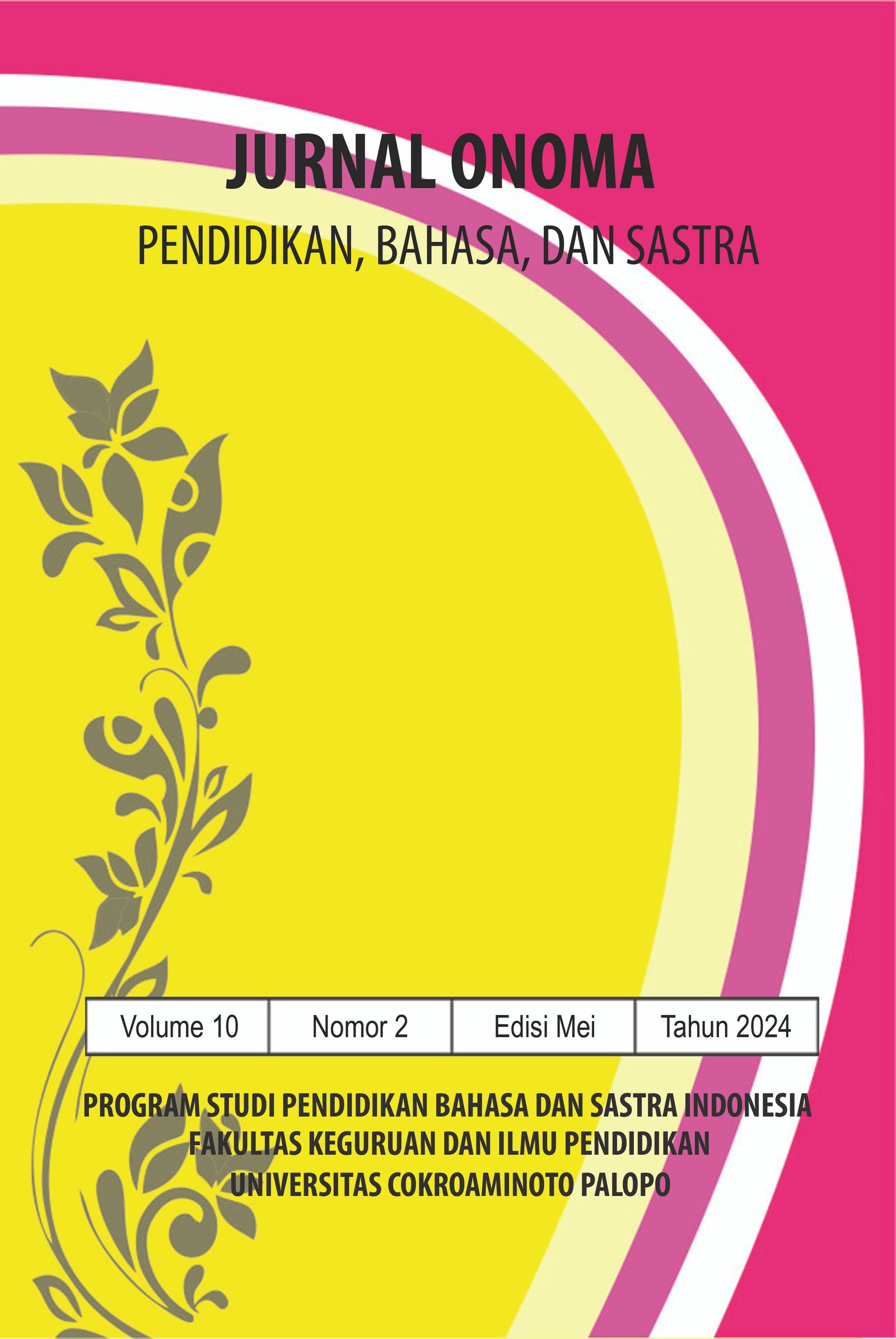From Text to Texture: Elevating English Teaching Through Visual Literacy Skills
https://doi.org/10.30605/onoma.v10i2.3595
Keywords:
Visual Literacy, Visual Design Principles, Visual Literacy TrainingAbstract
In an era dominated by visual media, this study examines the effects of visual literacy training on the ability of English teachers at Kalam Kudus Elementary School in Bali to create effective teaching materials. Utilizing a one-group pretest-posttest design, 21 teachers underwent training in the CRAP (Contrast, Repetition, Alignment, Proximity) principles. Data collected from pre-and post-tests, alongside a supplementary questionnaire, indicated a notable enhancement in teachers' visual literacy, with an average Gain score of 74.15%. Although the training was deemed moderately effective, educators experienced a significant boost in their understanding and application of visual design principles, contributing to the creation of more engaging educational content. The study highlights the need for continued professional development in visual literacy to address ongoing challenges, emphasizing its importance in improving educational practices.
Downloads
References
Aberšek. (2008). Visual Literacy – One of 21St Century Literacies for Science. Aberšek, 5.
Bachtiar, B. (2021). Professional Teaching and Learning Effectiveness: A Case of English Language Teaching in Indonesia. International Journal of Education, 14(1), 11–18. https://doi.org/10.17509/ije.v14i1.25533 DOI: https://doi.org/10.17509/ije.v14i1.25533
Bachtiar, Juhana, & Pratiwi, W. R. (2024). Indonesian English language teachers’ conceptions of critical thinking: challenge and strategy. International Journal of Evaluation and Research in Education , 13(1), 617–625. https://doi.org/10.11591/ijere.v13i1.26467 DOI: https://doi.org/10.11591/ijere.v13i1.26467
Baylen, D. M., & D’alba, A. (2015). Essentials of teaching and integrating visual and media literacy: Visualizing learning. In Essentials of Teaching and Integrating Visual and Media Literacy: Visualizing Learning. Springer International Publishing. https://doi.org/10.1007/978-3-319-05837-5 DOI: https://doi.org/10.1007/978-3-319-05837-5
Britsch, S. (2009). ESOL Educators and the Experience of Visual Literacy. TESOL Quarterly, 43(4). https://doi.org/DOI: 10.1002/j.1545-7249.2009.tb00197.x DOI: https://doi.org/10.1002/j.1545-7249.2009.tb00197.x
Duchak, O. (2014). Visual literacy in educational practice. Czech-Polish Historical and Pedagogical Journal, 6(2), 41–48. https://doi.org/10.247/cphpj-2014-0017 DOI: https://doi.org/10.2478/cphpj-2014-0017
Eilam, B. (2012). Teaching, learning, and visual literacy : the dual role of visual representation. Cambridge University Press. DOI: https://doi.org/10.1017/CBO9781139026611
Goldstein, B. (2016). Visual literacy in English language teaching. www.bbc.co.uk/news/resources/
Haddad, N. (2019). Utilizing Visual Literacy as A Communicative Discourse in the English Classroom: A Case Study. International Journal of Languages, Literature and Linguistics, 5(2), 51–61. https://doi.org/10.18178/ijlll.2019.5.2.204 DOI: https://doi.org/10.18178/IJLLL.2019.5.2.204
Huilcapi-Collantes, C., Martín, A. H., & Hernández-Ramos, J. P. (2020). The effect of a blended learning course of visual literacy for in-service teachers. Journal of Information Technology Education: Research, 19, 131–166. https://doi.org/10.28945/4533 DOI: https://doi.org/10.28945/4533
Kathleen Ellen O’Neil. (2011). Reading Pictures: Developing Visual Literacy for Greater Comprehension.
Kulamikhina, I., Kamysheva, E., & Samylova, O. (2021). Integrating Visual Literacy Teaching Into The English For Specific Purposes Course. 689–702. https://doi.org/10.15405/epsbs.2021.12.84 DOI: https://doi.org/10.15405/epsbs.2021.12.84
Maldonado, A. G. V. (2019). Visual literacy in adult English language teaching: An exploration of teachers’ understandings and self-reported practices. 268.
Özsoy, V., & Saribaş, S. (2021). Developing Visual Literacy Skills in Teacher Education: Different ways of looking at the visual images. Educational Policy Analysis and Strategic Research, 16, 2021. https://doi.org/10.29329/epasr.2020.373.5 DOI: https://doi.org/10.29329/epasr.2021.373.5
Villamizar, A. G. (2018). Examining intersections between visual literacy and digital technologies in English language programs for higher education. Journal of Visual Literacy, 37(4), 276–293. https://doi.org/10.1080/1051144X.2018.1522089 DOI: https://doi.org/10.1080/1051144X.2018.1522089
Yeh, H. Te, & Cheng, Y. C. (2010). The influence of the instruction of visual design principles on improving pre-service teachers’ visual literacy. Computers and Education, 54(1), 244–252. https://doi.org/10.1016/j.compedu.2009.08.008 DOI: https://doi.org/10.1016/j.compedu.2009.08.008
Downloads
Published
How to Cite
Issue
Section
License
In submitting the manuscript to the journal, the authors certify that:
- They are authorized by their co-authors to enter into these arrangements.
- The work described has not been formally published before, except in the form of an abstract or as part of a published lecture, review, thesis, or overlay journal.
- That it is not under consideration for publication elsewhere,
- That its publication has been approved by all the author(s) and by the responsible authorities – tacitly or explicitly – of the institutes where the work has been carried out.
- They secure the right to reproduce any material that has already been published or copyrighted elsewhere.
- They agree to the following license and copyright agreement.
License and Copyright Agreement
Authors who publish with Onoma Journal: Education, Languages??, and Literature agree to the following terms:
- Authors retain copyright and grant the journal right of first publication with the work simultaneously licensed under Creative Commons Attribution License (CC BY 4.0) that allows others to share the work with an acknowledgment of the work's authorship and initial publication in this journal.
- Authors are able to enter into separate, additional contractual arrangements for the non-exclusive distribution of the journal's published version of the work (e.g., post it to an institutional repository or publish it in a book), with an acknowledgment of its initial publication in this journal.
- Authors are permitted and encouraged to post their work online (e.g., in institutional repositories or on their website) prior to and during the submission process, as it can lead to productive exchanges, as well as earlier and greater citation of published work.

















